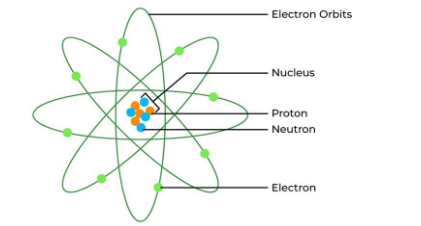Table of Contents
Introduction to Mass of Neutron
Neutrons are the atom’s fundamental subatomic particles. An atom is made up of electrons, protons, and neutrons. In 1932, English physicist James Chadwick discovered the neutron. Neutrons are charged particles with a higher mass.
They are symbolized by the number n. They live inside the nucleus of the atom and are known as nucleons, along with protons. In this essay, we’ll go over neutrons in depth.
Definition of Neutrons
Neutrons tend to be subatomic particles that constitute one of the fundamental constituents of atomic nuclei, along with electrons and protons. Neutron is a neutral subatomic particle found in all atomic nuclei except common hydrogen.
The electrons, protons, and neutrons inside an atom are depicted in the figure below.

Mass of electron proton and neutron
Mass spectroscopy can be used to determine the mass of electron proton and neutron. The mass of a proton and deuteron may be determined using a mass spectrometer, and the mass of the neutron can be computed by subtracting the mass of the proton from the mass of the deuteron, with the difference between the two being the mass of the neutron plus the energy of binding deuterium. The formula for calculating a neutron’s mass is as follows:
mn = md – mp + Bd -Erd
In this case, the mass of neutron is mn.
md = deuteron mass
mp denotes proton mass.
Bd = deuterium’s binding energy
Erd = kinetic energy recoil
Let’s look at neutron mass in amu and kg.
Mass of neutron in kg
The mass of neutron in Kg is 1.674 ×1027 kg.
Mass of neutron in amu
A mass of neutron in amu is 1.008665 amu, which means it’s about equal to 1 amu.
Mass of proton and neutron
The mass of a neutron can be estimated by deducting the mass of a proton from the overall mass of a deuterium nucleus (deuterium is a hydrogen isotope having a single proton, a single electron, and a neutron in its atomic structure). This is how the mass of proton and neutron are linked to each other.
A proton’s mass is the sum of the combined masses of its binding gluons and current quarks. It is equivalent to:
mp = 1.672621898(21) × 10−27 Kg
A proton has a greater mass than an electron.
Also Check:
Mass and charge of electron proton and neutron
The electron has a relative mass of 1 / 1840 u, the proton has 1 u, and the neutron has 1 u as well.
The electron has a relative charge of -1u, the proton has a charge of +1 u, and the neutron has no charge.
Atomic mass of neutron
A atomic mass of neutron is about the same as 1.008 atomic mass units.
Mass of neutron in grams
A neutron is a subatomic particle with no electrical charge and mass of neutron in grams is 1. 675 10-24 g, or approximately 1 amu, or approximately equivalent to the amount of mass of a proton or an atom of hydrogen.
Frequently Asked Questions(FAQs) on Mass of Neutron
What is the mass of a neutron?
Neutrons are subatomic particles that are neutrally charged. A neutron's mass is about equal to 1.008 atomic mass units. When measured in kilograms, the neutron's mass is approximately 1.674*10-27 kg.
Who discovered the charge and mass of a neutron?
The story starts in 1932, with the initial discovery of the neutron by English physicist Sir James Chadwick. Until 1932, the atom was thought to be composed of a positively charged nucleus surrounded by a sufficient number of negatively charged electrons to render the atom electrically neutral.
What are the properties of the mass of a neutron?
A neutron is an electrically uncharged primary subatomic particle with nearly 2000 times the mass of an electron. Despite the fact that neutrons are stable while bound in an atomic nucleus, their lifetime as a free particle is roughly 15 minutes.
What is the charge and mass of neutron?
Protons and neutrons possess roughly the same mass, 1.67 10-24 grams. This amount of mass is defined by scientists as a single atomic mass unit (amu) or one Dalton. Despite their comparable mass, protons are charged positively, whereas neutrons are neutral.









